Table Of Contents
- What Makes Osaka Japan Different From Other Food Cities
- When to Start Your Food Adventure (And Why Timing Matters)
- Getting Started: The Essential Osaka Map Strategy
- Stop 1: Kuromon Market - Where Locals Actually Shop
- Stop 2: Namba Station Area - The Heart of Osaka Street Food
- Stop 3: Shinsaibashi Shopping Street - Upscale Eating
- Stop 4: Central Osaka's Department Store Food Courts
- Stop 5: Osaka Castle Park - Perfect Picnic Territory
- Stop 6: Shinsekai Osaka - Old School Osaka Flavors
- Stop 7: Umeda Sky Building Area - Modern Flavors with Views
- Hidden Gems Most Food Tours Never Find
- Universal Studios Japan - When Theme Parks Do Food Right
- Day Trips from Osaka - Expanding Your Food Horizons
- Where to Sleep: Capsule Hotels and Food Access
- Shopping for Osaka Food Souvenirs
- Money Matters: Budgeting Your Food Adventure
- Food Safety and Cultural Etiquette
- Seasonal Eating: When to Find What
- Making It Your Own: Customizing the Route
- Beyond Food: Understanding Osaka Through Eating
- When Things Go Wrong: Problem-Solving Tips
- Creating Lasting Memories Beyond Instagram
- The Real Reason This Tour Changed My Life
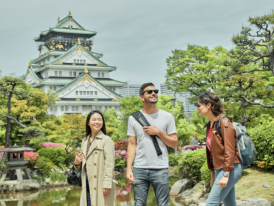
Young man in casual clothes standing in front of Osaka Castle with a smile
That's when I decided to fall in love with Osaka all over again, one bite at a time.
This isn't your typical food tour Osaka experience with a guide and a group. This is my self-guided food tour Osaka route, the one that brought me back to my city's soul. I'm sharing it because if you visit Osaka you deserve better than rushed tourist stops. She deserves slow mornings, lingering conversations, and the kind of eating that makes your pants tight and your heart full.

Traditional Japanese chef preparing Takoyaki at a street stall with focused concentration
What Makes Osaka Japan Different From Other Food Cities
Every food lover thinks their city is special. In Osaka's case, we're actually right.
As Japan's third largest city, Osaka earned the nickname "Osaka's kitchen" centuries ago, and we've been living up to it ever since. While Tokyo gets flashy and Kyoto stays traditional, we stay hungry. Street food here isn't a novelty — it's how we've always eaten. Our covered shopping arcade culture means you can eat your way through weather, seasons, and decades of family recipes.
The central osaka food scene moves fast but tastes slow. Vendors have been perfecting single dishes for generations. The guy making your okonomiyaki? His grandfather probably flipped the same batter on the same corner. That's the difference between eating in Osaka and just eating food somewhere that happens to be in Osaka.
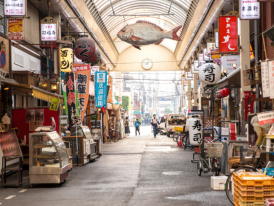
Early morning scene at Kuromon Market with vendors setting up stalls and morning light filtering through
When to Start Your Food Adventure (And Why Timing Matters)
Most who visit Osaka start their food tours after lunch. That's their first mistake.
Real food tours start when your stomach is empty and the city is waking up. I begin mine at 9 AM, when the morning rush fades and vendors start prepping for the day. This timing gives you the entire day to build flavors, take breaks, and eat at the pace Osaka was meant to be eaten — slowly, with conversation.
Avoid cherry blossom season if crowds stress you out. March through May brings beautiful weather but packed streets. For the best balance of comfortable weather and manageable crowds, aim for late September through November, or the quieter weeks of January and February.
When you visit Osaka your itinerary should always put food first, attractions second. This city rewards the hungry, not the hurried.
Looking for a private city experience in Osaka?
Explore the city with a local who plans a private day just for you; no groups, no scripts.
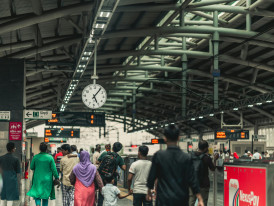
Busy Osaka Station platform with commuters and clear signage showing the loop line. Photo by Roktim Razee on pexels
Getting Started: The Essential Osaka Map Strategy
Before we dive into specific neighborhoods, let's talk logistics. Osaka station serves as the natural hub for any food tour, with the JR Osaka Loop Line connecting every neighborhood we'll hit.
Download an offline Osaka map before you start. Cell service gets spotty in some of the narrow alleyway spots, and you don't want to miss a turn because your GPS failed. The loop line runs every few minutes, making it easy to hop between districts without the stress of complicated transfers.
Your Japan rail pass covers the loop line, so budget-conscious travelers can eat their way around the city for the cost of ingredients alone. That's the beauty of street food — maximum flavor, minimum financial damage.

Narrow walking path through Kuromon Market with vendors on both sides and natural lighting.
Stop 1: Kuromon Market - Where Locals Actually Shop
Most food tours start at Kuromon Market, and they're not wrong. But they usually do it wrong.
The Kuromon market secret isn't the famous tuna sashimi stalls (though they're good). It's the tiny counters tucked between tourist spots where locals grab breakfast before work. Kuromon Ichiba Market has been feeding Osaka for over 190 years, and the morning energy still hits different.
What to Eat at Kuromon Market
Start with Kaisen-don at Kuromon Sanpei. Their rice bowls topped with fresh seafood set the bar high for everything that follows. The tuna melts on your tongue, but the real star is their house-made soy sauce blend that somehow makes the rice taste like the ocean.
Next, grab wagyu beef skewers from the stall near the market's center. Watch them grill the meat over charcoal, the char adds smokiness that complements the beef's richness without overpowering it. Each bite should taste like concentrated umami.
Don't skip the fruit vendors. Osaka's position as a trading hub means year-round access to perfect produce. Try whatever's in season — the vendors will let you taste before buying, and their recommendations never miss.
Kuromon Market Navigation Tips
The market runs east-west for about 600 meters. Enter from the Nippombashi side to avoid the worst crowds, and eat your way toward the Namba end. This flow puts you closer to our next stop and lets you experience the market's rhythm naturally.
Vendors speak basic English, but pointing and smiling works better than complex orders. Most stalls only accept cash, so hit an ATM before you arrive.
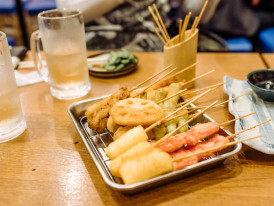
Kushikatsu being deep-fried in oil with golden brown color and crispy coating visible
Stop 2: Namba Station Area - The Heart of Osaka Street Food
After Kuromon, the Namba station district offers Osaka's most concentrated street food experience. This isn't tourist theater, it's where local office workers grab lunch and where families come for weekend treats.
The area around Namba pulses with energy. Every corner offers something different, from hole-in-the-wall ramen shops to standing bars where salary workers decompress over beer and yakitori. The key is following your nose and trusting your instincts.
Must-Try Street Food Near Namba
Takoyaki at Juhachiban has been my go-to since high school. Their batter-to-octopus ratio hits perfectly, and they don't skimp on the bonito flakes. Real Takoyaki should be creamy inside, with just enough structure to hold together when you bite it. Theirs achieves that texture every time.
Okonomiyaki varies wildly in quality around tourist areas. Skip the big signage and look for the place with the longest line of locals. My current favorite is a counter-only spot called Mizuno, where the chef's been perfecting her recipe for thirty years. Her Osaka style okonomiyaki layers flavors without competing; cabbage, pork, and that perfect balance of savory and sweet sauce.
Imagawayaki (round pancakes with filling) from street vendors make perfect walking snacks. The sweet red bean version tastes like comfort food, while the savory versions with cheese or vegetables work as mini-meals. Buy them hot — they lose their charm once they cool.
Hidden Namba Gems Most Tours Miss
Down a narrow alleyway behind the main tourist drag, Hozenji Yokocho offers izakaya culture in its purest form. These tiny drinking establishments serve small plates perfect for sharing, and the atmosphere feels like stepping back fifty years.
Order Kushikatsu at Daruma if you want the experience, but for better taste, try the smaller shops where they fry to order instead of keeping batches warm. Fresh Kushikatsu should crunch on the outside while staying tender inside, with breading that doesn't overwhelm the ingredient.
The covered shopping arcade connecting Namba to Shinsaibashi hides several family-run businesses that have survived decades of development. These spots focus on single dishes done exceptionally well rather than trying to please everyone.
What if your day in Osaka was planned by someone who knows it — and you?
City Unscripted matches you with a local host who creates a private experience based on your interests, not a set route.
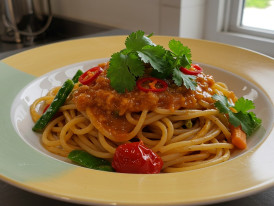
Fusion dish combining Italian pasta with Japanese dashi-based sauce and local ingredients
Stop 3: Shinsaibashi Shopping Street - Upscale Eating
After the intensity of Namba, Shinsaibashi Shopping Street offers a breather with slightly more upscale food options. This is where street food meets restaurant quality, and where locals come when they want to treat themselves.
The Shinsaibashi shopping food scene balances accessibility with refinement. You'll find vendors who've elevated traditional recipes with better ingredients and more careful preparation, but without the pretense of formal dining.
Upscale Street Food Worth the Extra Yen
Kobe beef skewers here actually use certified Kobe beef, unlike many tourist traps. The price reflects the quality — expect to pay 2-3 times normal beef skewer prices, but the marbling and tenderness justify the cost. Each bite melts without chewing, leaving behind rich, clean beef flavor.
Artisanal taiyaki shops have transformed the traditional fish-shaped pastry into an art form. Instead of just red bean filling, you'll find seasonal options like matcha cream, custard, or even savory versions with curry or cheese. The pastry itself tastes butter-rich and crispy, a significant upgrade from standard versions.
High-end takoyaki uses premium octopus and house-made sauces that transform the familiar dish. Some shops add truffle oil or use dashi made from high-grade bonito. The result tastes recognizable but elevated, familiar comfort food made special.
International Cuisine with Osaka Influence
Shinsaibashi's international cuisine shows how Osaka adapts global flavors to local tastes. Korean-Japanese fusion stands serve kimchi Takoyaki and bulgogi okonomiyaki that somehow work perfectly. The spice levels adjust to Japanese culture preferences while maintaining authentic Korean flavors.
Italian-Osaka hybrid shops create pasta with dashi-based sauces and pizza topped with local ingredients like Mentaiko or nori. These combinations sound wrong but taste surprisingly right, showing how food culture evolves through cross-pollination.
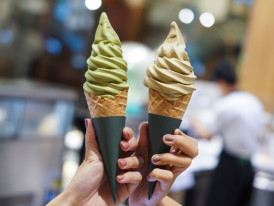
Premium matcha soft serve ice cream with rich green color and elegant presentation
Stop 4: Central Osaka's Department Store Food Courts
Don't dismiss department stores as tourist traps. The basement food courts (called Depachika) in Osaka's major department stores offer some of the city's best casual dining in air-conditioned comfort.
Department stores compete fiercely for local customers, so their food quality stays consistently high. These spaces offer relief from street heat while maintaining authentic flavors, plus they accept credit cards when your cash runs low.
Hanshin Department Store Basement
Hanshin's basement food court near Osaka station showcases regional specialties from across Japan. Their Hiroshima style okonomiyaki stall layers ingredients differently than Osaka's version — noodles and vegetables stay separate until the final flip, creating distinct texture layers.
Bento boxes here surpass convenience store versions by miles. Each compartment contains restaurant-quality preparations — seasoned vegetables, perfectly cooked proteins, and rice that tastes like someone's grandmother made it. These boxes work well for picnic lunches in nearby parks.
Daimaru Food Floor
Daimaru's food floor specializes in sweets and desserts that make perfect afternoon fuel. Their matcha soft serve uses ceremonial-grade powder that creates complex, slightly bitter flavor balanced by creamy sweetness. Much better than the tourist versions found around temples.
Traditional Wagashi (Japanese sweets) from multiple vendors let you compare different styles and techniques. These delicate confections pair perfectly with green tea and provide cultural context for understanding Japanese culture aesthetics beyond food.
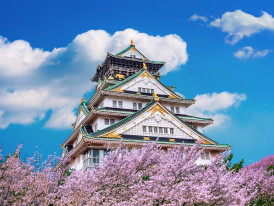
Cherry blossoms in full bloom with Osaka Castle
Stop 5: Osaka Castle Park - Perfect Picnic Territory
After hours of urban eating, the Castle park offers space to decompress while continuing your food adventure. The park's expansive grounds provide multiple picnic spots with castle views, making lunch feel special without restaurant prices.
The area around Osaka castle combines historical significance with practical amenities. Convenience stores stock fresh sandwiches and drinks, while food trucks offer hot options during peak seasons. The castle itself provides stunning backdrop photos for your food journey documentation.
Convenience Store Treasures
Japanese convenience stores elevate grab-and-go food to art form levels. Onigiri (rice balls) feature perfectly seasoned rice wrapped around high-quality fillings like salmon, tuna mayo, or pickled plum. The seaweed stays crispy thanks to clever packaging that keeps it separate until you're ready to eat.
Karaage chicken from convenience stores often surpasses restaurant versions. The coating stays crispy while the meat remains juicy, and the seasoning penetrates throughout rather than just coating the surface. Perfect protein for park lounging.
Cherry Blossom Season Considerations
During cherry blossom season, Osaka Castle becomes extremely crowded. Food vendors multiply, but quality often suffers due to volume demands. If you visit during peak bloom, arrive early morning for better food options and photography opportunities before tour groups descend.
The cherry blossom viewing tradition (Hanami) revolves around outdoor eating and drinking. Participating in this cultural practice adds depth to your food tour while connecting you with centuries of Japanese tradition.
Tip
We match you with the right host, not just any guide.Want to experience the real Osaka with someone who lives there?
A fully private experience, planned and led by a local host who tailors the day to you
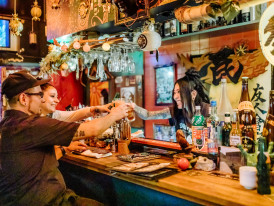
Traditional standing bar with locals drinking beer
Stop 6: Shinsekai Osaka - Old School Osaka Flavors
The Shinsekai Osaka district, centered around the iconic Tsutenkaku Tower, preserves Osaka's working-class food culture in its most authentic form. This historic neighborhood hasn't gentrified like other areas, so the food stays honest, cheap, and delicious. Shinsekai Osaka literally means "New World," but the irony is that it now represents old-school Osaka at its finest.
Kushikatsu originated in Shinsekai Osaka, and several shops in this district claim to serve the original recipe. The rules remain strict: no double-dipping in the communal sauce, and eat immediately while hot. The batter should shatter when you bite it, revealing perfectly cooked ingredients inside.
Authentic Kushikatsu Experience
Daruma gets the tourists, but locals prefer Tenji or Yokozuna for more consistent quality and lower prices. The key to great Kushikatsu lies in the oil temperature and timing — too hot burns the coating, too cool makes it greasy. Master chefs judge doneness by sound and bubbling patterns.
Doteyaki (beef stew) appears on most Kushikatsu shop menus as a side dish. This local specialty slow-cooks beef tendons in miso-based broth until the meat falls apart. The rich, savory flavor pairs perfectly with fried foods, cutting through grease while adding protein.
Traditional Drinking Culture
This area's standing bars (Tachinomi) offer the most authentic Japanese drinking experience outside of major cities. Order beer or highballs, then choose from small plates displayed on counters. The atmosphere stays loud, friendly, and unpretentious.
Conversation flows easily here, even with limited Japanese language skills. Locals appreciate visitors who respect the customs — order promptly, eat standing up, and settle your bill before leaving.
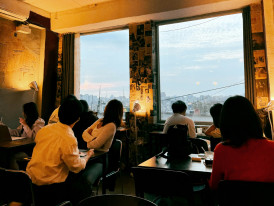
Panoramic view of Osaka city from the observation deck with diners enjoying meals at window tables Photo by Navyorange.jpeg on Unsplash
Stop 7: Umeda Sky Building Area - Modern Flavors with Views
The area around Umeda sky building represents modern Osaka's approach to food — innovative techniques applied to traditional flavors, often with spectacular city views as backdrop.
The floating garden observatory offers 360-degree city views, but the real attraction for food lovers lies in the basement restaurants and nearby streets. This district showcases how contemporary Japanese cuisine evolves while respecting traditional foundations.
Elevated Dining Options
Modern ramen shops near the sky building experiment with non-traditional ingredients while maintaining proper technique. Some use truffle oil, others incorporate Western herbs, but the broth fundamentals — long simmering times and carefully balanced flavors — remain unchanged.
Kaiseki-style bento boxes available from upscale vendors showcase seasonal ingredients arranged with artistic precision. These meals cost more than street food but provide insight into Japanese culinary philosophy — harmony between taste, texture, color, and season.
Observation Deck Dining
The Umeda sky building's observation deck restaurants combine stunning views with solid food. The entrance fee includes access to multiple dining options, making it worthwhile for the experience even if the food doesn't quite match street-level quality.
Sunset timing transforms ordinary meals into memorable experiences. The observation deck provides perfect vantage points for understanding Osaka's sprawling geography while digesting your day's food adventures.

Late-night ramen stand with neon lighting and a few customers eating at the counter.
Hidden Gems Most Food Tours Never Find
Real locals don't eat where tour groups gather. The best Osaka experiences happen in unmarked doorways, basement counters, and residential neighborhoods where rent stays affordable enough for family businesses to survive.
Mama-san shops in residential areas serve home-style cooking that restaurants can't replicate. These tiny establishments seat 6-8 people maximum, with menus that change based on available ingredients and the owner's mood. Quality stays consistently high because regulars demand it.
University district food stalls cater to students, meaning large portions at low prices without sacrificing taste. The competition stays fierce, so bad shops don't survive long. These areas offer authentic local flavors without tourist markup.
Late Night Food Culture
Osaka's vibrant nightlife extends to food vendors who operate only after dark. Late-night ramen stands serve different styles than daytime shops — richer broths designed to soak up alcohol, and heartier toppings for sustained energy.
Convenience store hot food peaks in quality after 9 PM when fresh batches replace day-old items. The Karaage chicken and Takoyaki taste noticeably better, and the selection expands to include items not available during busy daytime hours.
Ready to plan your perfect day in Osaka?
Start your experience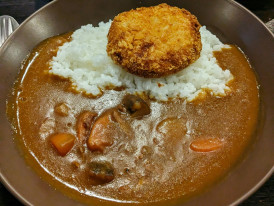
Japanese curry rice served at Universal Studios Photo by Markus Winkler on Unsplash
Universal Studios Japan - When Theme Parks Do Food Right
Universal Studios Japan proves that theme park food doesn't have to disappoint. Their Harry Potter area's Butterbeer and themed foods maintain surprisingly high quality while delivering Instagram-worthy presentation.
The Wizarding World restaurants serving Japanese British that works better than expected. Fish and chips use Japanese-style light batter, while traditional British desserts incorporate local ingredients like matcha and red bean.
Beyond Harry Potter Food
Universal Studios' Japanese curry stands throughout the park offer comfort food that satisfies without breaking budgets. The curry uses familiar spice blends but incorporates local vegetables and serving styles that feel distinctly Osaka.
Churros with unique Japanese flavors like matcha, purple sweet potato, and seasonal fruit create snacks worth seeking out. The churros stay crispy outside while remaining tender inside, and the flavor combinations work surprisingly well.
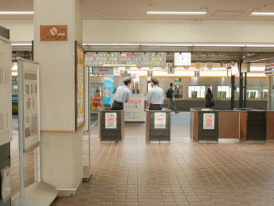
Modern airport food court at Kansai International Airport with various Japanese food stalls Photo by Mak on Unsplash
Day Trips from Osaka - Expanding Your Food Horizons
When Osaka's food scene feels explored, nearby destinations offer day trips that expand your culinary horizons while remaining easily accessible via Japan rail pass.
Kansai Region Food Adventures
Nara's free roaming deer create unique dining atmosphere, but the city's Kakinoha-zushi (persimmon leaf sushi) offers flavor experiences unavailable in Osaka. The leaves impart subtle earthy notes while preserving the rice's freshness.
Kobe beef in its birthplace tastes noticeably different from Osaka versions. The preparation stays simpler, letting the meat's natural flavors dominate. Even basic Teppanyaki preparations showcase why this beef commands premium prices worldwide.
Kansai International Airport Food Scene
Don't dismiss Kansai airport food as typical airport fare. The international cuisine options include several Osaka-style dishes prepared specifically for departing visitors wanting one final taste of local flavors.
Airport ramen shops serve respectable versions of Osaka favorites, while souvenir food stalls offer packaged versions of local specialties that travel well. The cup noodles museum products make practical gifts that capture authentic flavors.
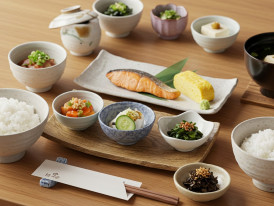
Traditional Japanese breakfast spread at a ryokan with multiple small dishes and rice.
Where to Sleep: Capsule Hotels and Food Access
Your accommodation choice affects food access significantly. Capsule hotels near major train stations provide budget-friendly lodging with easy access to late-night food options and early morning markets.
Hotel breakfasts in business hotels often feature local specialties alongside Western options. These buffets let you try multiple Osaka dishes in single sittings, perfect for expanding your palate efficiently.
Neighborhood Accommodation Strategy
Staying near Namba or Osaka station puts you within walking distance of major food districts while providing excellent public transportation access. Business hotels in these areas often include complimentary breakfast featuring local ingredients.
Traditional ryokan experiences, while more expensive, include kaiseki dinners that showcase Japanese culinary artistry. These multi-course meals provide cultural context for understanding Japanese food philosophy beyond street-level experiences.
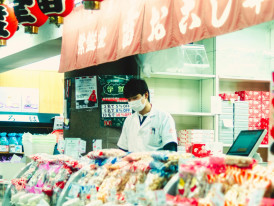
Packaged Japanese food souvenirs including Takoyaki mix, sauces, and local snacks arranged for display.Photo by Louis_ftn_on pexels
Shopping for Osaka Food Souvenirs
Department stores basement levels offer the best selection of packaged Osaka specialties that travel well. Takoyaki sauce, okonomiyaki mix, and local snacks let you recreate flavors at home while sharing authentic tastes with friends.
What Actually Travels Well
Instant Takoyaki mix requires only hot water and produces surprisingly authentic results. The packages include proper sauce and bonito flake packets that recreate the original flavor profile accurately.
Local sake from Kansai region breweries offers liquid souvenirs that capture terroir and tradition. Plum wine (Umeshu) made with Osaka-area fruit provides sweeter alternatives that appeal to broader palates.
Traditional sweets in decorative packaging make elegant gifts while showcasing Japanese aesthetic sensibilities. These confections keep well during travel and provide lasting reminders of your food journey.
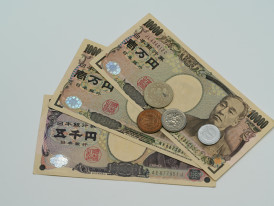
Japanese yen bills and coins arranged Photo by Q L on pexels
Money Matters: Budgeting Your Food Adventure
Street food keeps costs reasonable, but expenses add up quickly when eating all day. Budget 3,000-5,000 yen per person for comprehensive food tours including drinks, snacks, and one substantial meal.
Cost-Saving Strategies
Convenience store combinations provide filling meals for under 500 yen. Pair onigiri with miso soup and vegetables for balanced nutrition at fraction of restaurant costs.
Department store food courts during lunch hours offer set meals that compete with restaurants in quality while maintaining reasonable prices. These options work well for substantial meals between street food snacks.
Happy hour specials at standing bars provide alcohol and small plates at significant discounts. Timing your visits during off-peak hours stretches budgets while maintaining authentic experiences.
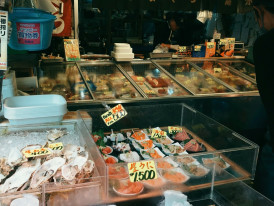
Clean and busy sushi counter with fresh fish displayed on ice and active preparation Photo by Alicja Podstolska on Unsplash
Food Safety and Cultural Etiquette
Raw fish at reputable vendors poses minimal risk due to strict handling standards and rapid turnover. Trust busy stalls where ingredients move quickly rather than places with empty display cases.
Dining Etiquette Basics
Slurping noodles shows appreciation and enhances flavor by aerating the broth. Finishing everything on your plate demonstrates respect for the chef and ingredients.
Tipping isn't expected and can cause confusion. Excellent service is considered standard rather than worthy of additional compensation.
Photography of food is generally acceptable, but ask permission before photographing people or restaurant interiors. Most vendors appreciate social media exposure but prefer being asked first.
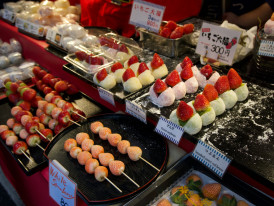
Festival food stalls with yakitori, chocolate bananas, and other festival snacks with festive lighting Photo by Marek Lumi on Unsplash
Seasonal Eating: When to Find What
Spring brings cherry blossom themed sweets and bamboo shoot dishes. Summer features Kakigori (shaved ice) and cold noodle preparations that provide relief from humidity.
Fall showcases persimmon, chestnut, and sweet potato preparations. Winter emphasizes hot pot dishes and warming drinks like amazake (sweet rice drink).
Seasonal Festival Foods
Summer festivals feature yakitori stalls and festival snacks like chocolate bananas and cotton candy. Winter illuminations pair with hot chocolate and Taiyaki vendors.
New Year brings special mochi preparations and traditional sweets that appear only during holiday seasons. These limited-time offerings provide unique cultural experiences unavailable during regular visits.
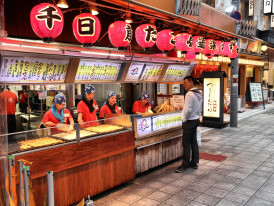
Friendly food vendor chatting with repeat customers at their stall, showing personal relationships
Making It Your Own: Customizing the Route
This route works as written, but the best food adventures adapt to personal preferences and energy levels. Skip attractions that don't interest you, spend extra time in neighborhoods that click, and follow spontaneous recommendations from locals you meet.
Personal Pace Adjustments
Food lovers might spend entire days in single neighborhoods, while attraction-focused travelers can hit highlights efficiently between major sights. Energy levels matter more than strict schedules.
Weather contingencies should include indoor options like shopping arcade food courts and department store basements. Rain doesn't have to ruin food adventures when you know covered alternatives.
Building Your Own Food Network
Regular vendors remember customers who return multiple times. Building relationships with food stall owners and restaurant staff creates insider access to special preparations and recommendations.
Local social media groups often share temporary food events and limited-time offerings. Following Osaka food accounts on Instagram reveals pop-up vendors and seasonal specialties that guidebooks miss.

Group of people sharing various dishes at a traditional low table in Japanese style Photo by Kristian Angelo on Unsplash
Beyond Food: Understanding Osaka Through Eating
Food reveals cultural values that attraction visits miss. Sharing dishes demonstrates Japanese community orientation, while seasonal ingredients showcase environmental awareness and aesthetic sensibility.
Convenience store culture reflects urban lifestyle adaptations and technological innovation applied to daily needs. Department store food floors illustrate Japanese attention to presentation and quality standards.
Cultural Insights Through Cuisine
Regional differences between Osaka and Tokyo styles reveal historical rivalries and distinct identity development. International fusion dishes show how global influences adapt to local tastes rather than replacing them.
Generational changes appear in vendor ages and preparation methods. Traditional techniques coexist with modern innovations, creating dynamic food scenes that honor the past while embracing change.

Tourist showing a translation card to a food vendor who is smiling and nodding in understanding Photo by Beth Macdonald on Unsplash
When Things Go Wrong: Problem-Solving Tips
Language barriers resolve through pointing, smiling, and patience. Most vendors handle international customers regularly and adapt their communication accordingly.
Dietary restrictions require advance research and clear communication. Vegetarian and halal options exist but need specific seeking. Allergy concerns necessitate written cards in Japanese explaining restrictions.
Common Issues and Solutions
Overwhelm from too many options resolves by focusing on single neighborhoods rather than trying to experience everything simultaneously. Decision fatigue improves with predetermined food categories rather than open-ended choices.
Stomach capacity limits require strategic pacing and sharing options. Rest periods between intensive eating allow proper digestion and renewed appetite for subsequent experiences.

Hand-written food journal with sketches and notes about various dishes, lying next to some Osaka street food
Creating Lasting Memories Beyond Instagram
Food journals capture flavors better than photographs alone. Writing descriptions of tastes, textures, and atmospheres preserves sensory memories that fade over time.
Recipe collecting from vendors who share techniques creates opportunities for home recreation and continued connection to experiences. Ingredient sourcing information helps maintain flavor connections after returning home.
Long-term Connection Building
Annual return visits reveal seasonal changes and business evolution. Relationship maintenance with favorite vendors creates insider access and special treatment during subsequent trips.
Cultural exchange through food discussions builds understanding that extends beyond tourism into genuine cultural appreciation and personal growth.

Sunset view over Osaka with the city neon lights beginning to twinkle photo by TimBray on Creative Commons Attribution-Share Alike 4.0
The Real Reason This Tour Changed My Life
Six months later, I'm still discovering new corners of my hometown. Not because Osaka changed, but because I learned how to see it through hungry eyes again.
Food tours aren't really about food. They're about slowing down enough to taste where you are. They're about conversations with strangers who become temporary friends. They're about remembering that the best adventures happen when you follow your stomach instead of your schedule.
This self-guided food tour route brought me home to myself as much as to my city. It reminded me that great food doesn't require great expense, that authentic experiences hide in plain sight, and that the best way to understand a place is to eat it slowly, with gratitude and attention.
Your Next Steps
Start planning your own unforgettable adventure through Osaka's food scene. Remember that the perfect food tour isn't about hitting every spot on someone else's list — it's about discovering the flavors that speak to your particular palate and pace.
Whether this becomes your first trip to Osaka or your fifteenth, approach it with beginner's mind and empty stomach. The city rewards both equally.
For more authentic Osaka experiences beyond food, or to discover other things to do in Osaka that complement your culinary adventures, remember that the best travel happens when you balance planning with spontaneity, research with discovery, and hunger with satisfaction.
Itadakimasu! (Let's eat!)
What if your day in Osaka was planned by someone who knows it — and you?
City Unscripted matches you with a local host who creates a private experience based on your interests, not a set route.
Want to experience the real Osaka with someone who lives there?
A fully private experience, planned and led by a local host who tailors the day to you










